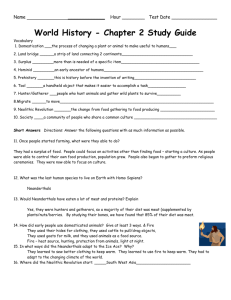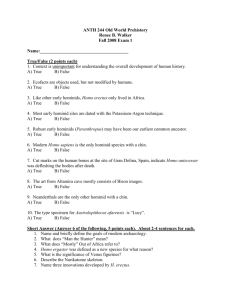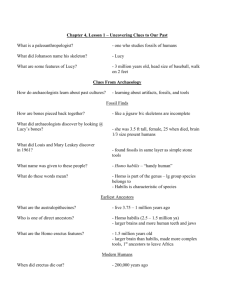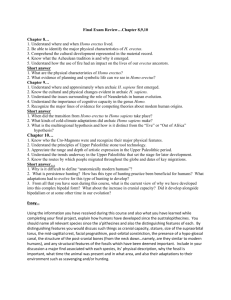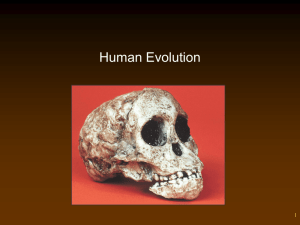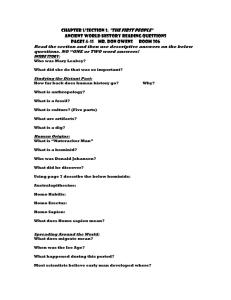Homo erectus
advertisement
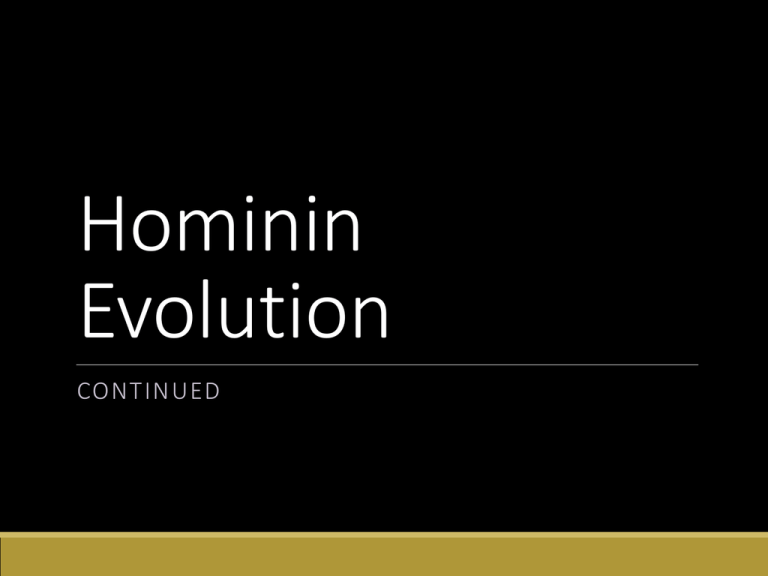
Hominin Evolution CONTINUED Learning Objectives 1. Describe the anatomical features of the Nariokotome boy 2. Identify the geographical areas where H. erectus fossils have been found, and the first fossil site outside of Africa. 3. Describe the unique anatomical features of the Neanderthals. 4. Describe the latest findings in DNA analysis of Neanderthals 5. Identify the anatomical features of Homo sapiens 6. Understand the debate concerning the taxonomic placement of the 5-year old child from Europe. Homo erectus Homo erectus (“upright man”) Widely distributed species: ◦1st to _______________ ◦Towards:________________ ◦Oldest specimens of this species are found in ___________ ◦___________ geographical regions Distribution of H. erectus Sites Nariokotome Boy (KNM-WT 1500) Location: Nariokotome, Africa Time period: ___________ _________________________ Estimated adult height: ___________ Nariokotome Boy (KNM-WT 1500) ‘Modern-like’ ◦ ________________ ◦ Why is this important? Expansion ____________ _________________ ◦ What areas of the body provide information on growth & development? Beijing, China: Zhoukoudian Cave (Dragon Bone Hill) 40 M/F adults and children ◦ ________________________ 670,000-410,000 years old ◦ _______________________ ◦ Longest history of visitation Exhibit typical ____________________ ◦ Few postcranial fossils found Beijing, China: Zhoukoudian Cave (Dragon Bone Hill) Cultural remains: ◦ ______________________ ◦ Diet: ___________________ ◦ Harsh winters: ___________ Beijing, China: Zhoukoudian Cave (Dragon Bone Hill) Evidence for _____________ ◦ _____________ animal bone, stone tools, plants, ash along with bird eggs and seeds ◦ Suggest: ____________________ Homo erectus in Europe: Gran Dolina Found the following: ◦ ______________ ◦ ______________ ◦ _______________ Evidence for ________________________ Most complete skull – __________ ◦ Facial bones, mandible, teeth Archaic Homo sapiens Archaic Homo sapiens Who are they? Specimens displaying mixtures of _____________ and ___________________ Proposed to separate these individuals into a distinct species. ◦ Homo antecessor (non-Africa) ◦ Homo heidelbergensis (Africa) We are going to keep Archaic Homo sapiens Archaic Homo sapiens Exhibit several ________________________ BUT also possess characteristics that are __________ _________________________________________ ◦ Example of ____________________ Spans three geographical areas ___________________ ◦ These areas are the same as ________ ◦ and _______________ Neanderthals Where in the World are Neanderthals? Neanderthals Lived during the last major ice age ◦ Anatomical features ___________ ____________________________ Features: ◦ 1. ◦ 2. ◦ 3. ◦ 4. ◦ 5. Asia – Israel Kebara Partial skeleton (60,000ya) ____________________ Even without cranium & legs, _________________________ What can we tell from the torso? ____________ __________________ Asia – Israel - Kebara Hyoid ◦ Variation in morphology of the human hyoid is ________ ◦ Kebara hyoid – __________________ ◦ What does this imply? ◦ Morphology ◦ Language Europe – La Chapelle-aux-Saints Typical Neanderthal morphology Evidence of ______ _________________ Europe – La Chapelle-aux-Saints Evidence of ____________ ◦ Body position = ________ Position suggests that _____ was taken when burying the body ◦ ______________________ Flexed Position Culture of Neanderthals Speech ◦ Probably were capable of _____________ ◦ Evidence based on: hyoid bone (found at Kebara) ◦ What else do we know? ◦ What did the movie say? ◦ __________ Anatomically Modern Humans (AMHs) _________ ______________________ _____________ __________ Africa – Ethiopia – Herto Herto = Earliest AMH ______________ = 160,000-154,000 Characteristics are essentially modern Cranium and dental remains found: ◦ ________________ ◦ ___________________ Africa – Ethiopia – Herto Europe ––Abrigo do Lagar Velho 24,500ya ____________________ Associated with: ◦ 1. ◦ 2. Europe ––Abrigo do Lagar Velho Anatomically a __________ of _________________ and _______________features ◦ __________________: regional Neanderthals and early modern humans
